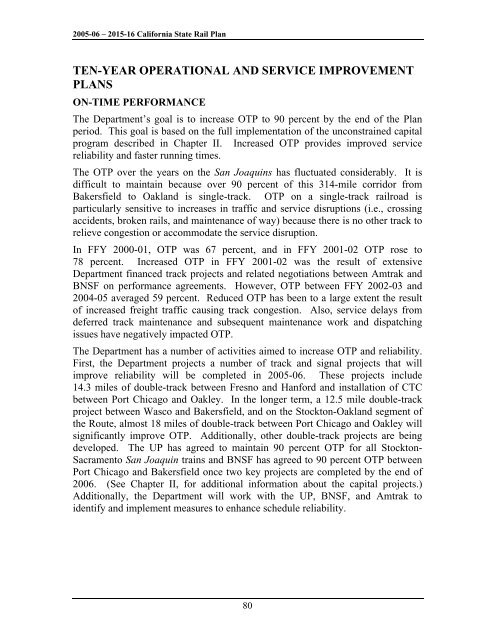California State Rail Plan 2005-06 to 2015-16
California State Rail Plan 2005-06 to 2015-16
California State Rail Plan 2005-06 to 2015-16
Create successful ePaper yourself
Turn your PDF publications into a flip-book with our unique Google optimized e-Paper software.
<strong>2005</strong>-<strong>06</strong> – <strong>2015</strong>-<strong>16</strong> <strong>California</strong> <strong>State</strong> <strong>Rail</strong> <strong>Plan</strong><br />
TEN-YEAR OPERATIONAL AND SERVICE IMPROVEMENT<br />
PLANS<br />
ON-TIME PERFORMANCE<br />
The Department’s goal is <strong>to</strong> increase OTP <strong>to</strong> 90 percent by the end of the <strong>Plan</strong><br />
period. This goal is based on the full implementation of the unconstrained capital<br />
program described in Chapter II. Increased OTP provides improved service<br />
reliability and faster running times.<br />
The OTP over the years on the San Joaquins has fluctuated considerably. It is<br />
difficult <strong>to</strong> maintain because over 90 percent of this 314-mile corridor from<br />
Bakersfield <strong>to</strong> Oakland is single-track. OTP on a single-track railroad is<br />
particularly sensitive <strong>to</strong> increases in traffic and service disruptions (i.e., crossing<br />
accidents, broken rails, and maintenance of way) because there is no other track <strong>to</strong><br />
relieve congestion or accommodate the service disruption.<br />
In FFY 2000-01, OTP was 67 percent, and in FFY 2001-02 OTP rose <strong>to</strong><br />
78 percent. Increased OTP in FFY 2001-02 was the result of extensive<br />
Department financed track projects and related negotiations between Amtrak and<br />
BNSF on performance agreements. However, OTP between FFY 2002-03 and<br />
2004-05 averaged 59 percent. Reduced OTP has been <strong>to</strong> a large extent the result<br />
of increased freight traffic causing track congestion. Also, service delays from<br />
deferred track maintenance and subsequent maintenance work and dispatching<br />
issues have negatively impacted OTP.<br />
The Department has a number of activities aimed <strong>to</strong> increase OTP and reliability.<br />
First, the Department projects a number of track and signal projects that will<br />
improve reliability will be completed in <strong>2005</strong>-<strong>06</strong>. These projects include<br />
14.3 miles of double-track between Fresno and Hanford and installation of CTC<br />
between Port Chicago and Oakley. In the longer term, a 12.5 mile double-track<br />
project between Wasco and Bakersfield, and on the S<strong>to</strong>ck<strong>to</strong>n-Oakland segment of<br />
the Route, almost 18 miles of double-track between Port Chicago and Oakley will<br />
significantly improve OTP. Additionally, other double-track projects are being<br />
developed. The UP has agreed <strong>to</strong> maintain 90 percent OTP for all S<strong>to</strong>ck<strong>to</strong>n-<br />
Sacramen<strong>to</strong> San Joaquin trains and BNSF has agreed <strong>to</strong> 90 percent OTP between<br />
Port Chicago and Bakersfield once two key projects are completed by the end of<br />
20<strong>06</strong>. (See Chapter II, for additional information about the capital projects.)<br />
Additionally, the Department will work with the UP, BNSF, and Amtrak <strong>to</strong><br />
identify and implement measures <strong>to</strong> enhance schedule reliability.<br />
80













